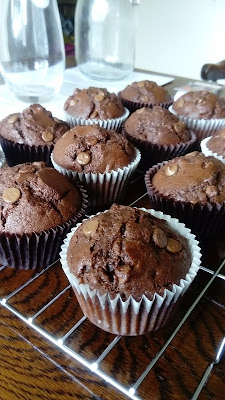
After experimenting over the course of a few days (which you can read all about here) I found what I consider to be the perfect scone: light and fluffy with pale sides and a brown top, with only a little hit of sweetness. I like my scones very plain.
To get the consistency of texture, the dough has to be worked through properly. This is tricky with something like scones, which need to be handled as little as possible before baking so they don't get tough. The way around this is to add some extra starch to reduce the overall amount of gluten in the flour. With a higher percentage of starch, the scones are lighter, fluffier, and easier to work with.
Split these beauties in half and enjoy with jam, butter, or cream. Or maybe all of the above, if you're feeling indulgent....
~~ ^ _ ^ ~~
DIFFICULTY
Very simple!
TIME
1 hour
RECIPE RATING
Easy!
~~ ^ _ ^ ~~
INGREDIMENTS
6 ounces (170 grammes) white plain flour: spelt or wheat
2 ounces (55 grammes) cornflour
1 tablespoon baking powder, or 1 teaspoon of baking powder with 1/2 teaspoon of baking soda for Irish style scones
1/4 teaspoon salt
2 ounces (55 grammes) butter, room temperature
2 tablespoons (28 grammes) caster sugar
4 fluid ounces (115 millilitres) milk, room temperature
1 teaspoon lemon juice, if using baking soda
Eggwash, made with an egg and a pinch of salt, or you can use milk to omit the egg
METHOD
- Preheat the oven to 200°C (400°F) and preheat a flat baking tray also.
- Sieve the flours, baking powder (and baking soda, if using), and salt twice, making sure to hold the sieve high. I like to sieve the mixture out onto a piece of baking paper, then back into the mixing bowl.
- In a mixing bowl, rub the sieved ingredients with the butter until it's like fine breadcrumbs. It doesn't matter what temperature the butter is, as long as it's very well rubbed in. Stir in the sugar.
- Add the milk (and lemon juice, if using baking soda) and mix quickly and throroughly with a metal spoon until just mixed.
- Turn out onto a floured work surface and chaff six times: chaffing is the process of flattening the dough by hand, folding in half, turning through 90 degrees, and then repeating. This is a much gentler process than kneading.
- Cut out scones using a cutter, shape the dough into a rectangle and cut squares, or shape into a round and cut into wedges. You can gather the remaining dough and re-roll, but the second rolling won't be as even as the first.
- Sprinkle flour onto the preheated tray and arrange the scones about half an inch apart from each other: if they're a little huddled together, they will rise straighter. Eggwash the tops, making sure it doesn't dribble down the sides. If you like, you can baste the tops with eggwash another two times during cooking for an even richer colour. You can also sprinkle the tops with coarse sugar or salt.
- Bake near the top of the oven for 15 minutes. This can depend on the size of the scones: when they've risen high and have turned a rich brown on top, they're ready.
These are best eaten the day they are made, but they freeze very well. Freeze any leftovers on the day of baking for best results.





































